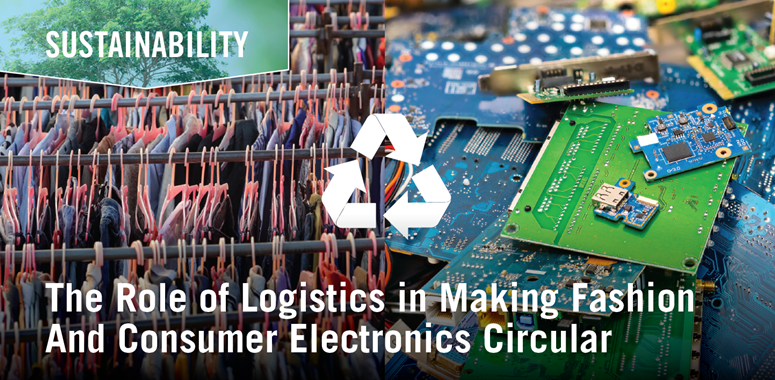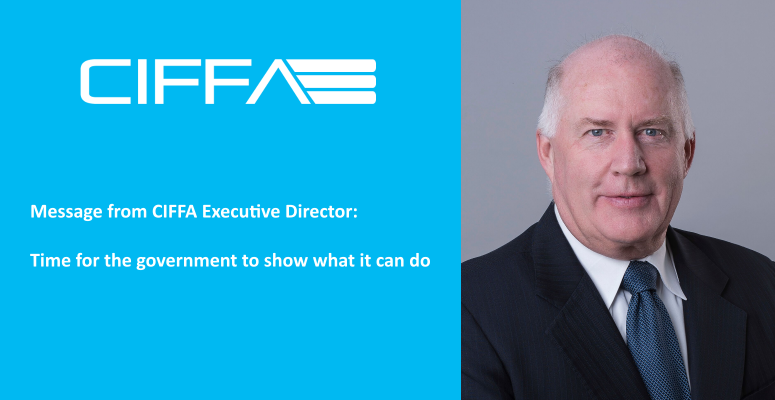
The role of logistics in making fashion and consumer electronics circular
A February 2022 whitepaper from DHL discussed the topic of circularity, and its role in fashion and consumer electronics.
At its heart, circularity describes a departure from the traditional produce-sell-use-waste paradigm toward more sustainability.
A circular economy could be thought of as a design for an ecosystem that builds on sustainability, visibility, and multidirectional flows. To move away from the traditional paradigm, production volumes and materials need to be optimized, product life cycles must be extended, new models for product use have to be developed, and solutions for end-of-life recycling need to be found.
According to research, this shift in the supply chain paradigm has the potential to cut emissions by up to about 40%, and it is more cost effective than any other approach to decarbonizing the supply chain.
Circularity can also positively impact other environmental and social issues, such as waste, land use, water use, and poor working conditions.
Because of its potential, circularity has received substantial attention across stakeholders and industries as a leading and holistic solution. Fashion and consumer electronics are at the center of the conversation and predestined as frontrunners in the solution given the characteristics of the products, consumption behaviors and usage-waste cycles within these industries. Since increased circularity builds on an increasing number of multidirectional flows of goods, logistics service providers are the needed enablers and accelerators of the transition.
As such, this particular stakeholder group is positioned to take on the task of redesigning these flows in highly efficient, user-friendly ways.
According to the whitepaper, the fashion and consumer electronics industries drive a large share of GHG emissions and other environmental impacts (including resource, land and water use, as well as waste).
Together, their carbon footprint makes up approximately 6% of global emissions. Consider that currently, around 20% of garments produced are never used, and smartphones are often exchanged after just 2–3 years.
Therefore, the positive impact that circularity in these two industries could have is pronounced, and industry front-runners are actively participating in the paradigm shift toward circularity.
WHY FASHION AND CONSUMER ELECTRONICS ARE IDEAL CANDIDATES FOR CIRCULARITY
Manufacturing in both fashion and consumer electronics requires vast amounts of often nonrenewable resources (including raw materials and energy inputs) and is the source of significant emission levels.
Compared to leading sectors such as automotive parts, for example, the reuse, refurbishing, and recycling processes in fashion and consumer electronics are less advanced and widespread.
Fashion and consumer electronics have high reach and relevance to almost everyone. Some sectors are relatively niche, others have larger consumer bases – and then there is fashion and consumer electronics: almost every consumer is active in these two retail categories in both their private and professional lives.
The supply chains of these two sectors are very complex and globalized. They cross many continents and companies, necessitating sophisticated coordination in the supply chain for maximum impact.
Fashion and consumer electronics have high visibility and multiplier effects. The industries are often in the focus of media attention and play a prominent role in the public dialogue. A move toward circularity in fashion and consumer electronics could therefore have broad signaling effects beyond the two industries, with both potentially serving as role models and helping other industries become more circular.
While fashion and consumer electronics represent particularly large opportunities in circularity, many of the circularity challenges are universal. Hence, the insights presented here can potentially be applied to other sectors, and industries across the board could certainly mitigate their environmental impacts by making circularity a bigger part of their product life cycles.
The global fashion and consumer electronics industries have a sizable impact on climate change. A conservative estimate for the fashion sector suggests that it is responsible for about 4% of annual global GHG emissions (up to 8%, according to other sources) and that the consumer electronics sector’s share of GHG emissions is approximately 2%. Combined, these sectors represent twice the share of GHG emissions of the aviation industry (3%).
At current consumption levels and under current approaches to managing the life cycles of these products, emissions from these industries would grow by 60% until 2030 and account for around 20% of the UN GHG emissions target for 2030, which is set at half of today’s emissions.
The fashion industry depends on non-renewable resources as well, as synthetic fabrics (such as polyester) are often produced using fossil fuels. Another major issue is the extensive land use required by these industries. Fashion clearly has the largest impact, requiring 40 million hectares, mostly for cotton farming. This means that an area larger than the size of Germany and Switzerland combined is used.
Waste from fashion products is often landfilled or incinerated – about 75% of the produced volume – causing additional emissions.
For example, in fashion, 71% of carbon emissions occur in the production phase, while around 20% of emissions are caused during product use (especially by washing).
The 5 Rs of circularity – reduce, repair, resell, refurbish, recycle – provide the critical dimensions along which circularity can be achieved.
REDUCE:
There is significant overproduction, especially in fashion (20-30%). “Reduce” is the circularity “R” that refers to production, and it does so in two ways. First, it aims to reduce the overall volume; fewer new products need to be manufactured when the lives of existing products are significantly extended, production is increasingly on demand and overproduction is limited. Second, circularity also means that the profile of product inputs changes, where a shrinking share of inputs are raw/virgin materials and the negative impact of resource and materials use shrinks accordingly.
REPAIR:
Fixing damaged products whenever possible, either via do-it yourself home repair or via professional repair services, is a clear intervention toward extending the life and maintaining the value of many consumer goods. Several fashion companies are already piloting offerings for fashion repair in combination with consumer education (for example, Patagonia’s free repair offering to end consumers). In consumer electronics, Apple recently announced an offering of spare parts for common phone and laptop repairs to consumers, albeit limited to selected models. Government legislation known as “right to repair” reinforces this activity by ensuring that goods – particularly household appliances – are manufactured with ease of repairability in mind.
RESELL:
The average time a fashion product is used is little more than 3 years. That length of time is just 2 to 3 years for smartphones. Reselling is the opportunity for a product owner to sell products that are still highly functional but that they no longer wish to use. The reduction in GHG emissions from resale is significant, but resale rates in fashion and consumer electronics are lower than they are in other sectors –for example in automotive, where reselling cars is the default.
In addition, there is a significant volume of totally unused fashion products (about $2.1 trillion) in consumers’ closets around the world. For example, the average UK consumer owns unused garments worth $270. These products could be put to productive use via resale. Strong moves in this resale direction are already visible today, for example, in the fashion industry.
A new ecosystem of digital resale-as-a-service offerings is emerging, where players such as Trove and Reflaunt operate the resell business on behalf of brands and retailers. In addition, both established (such as eBay, Zalando) and recently launched (such as Vinted) independent digital marketplaces allow for a peer-to-peer resale of garments.
Globally, use of recycled materials in fashion production remains low, with about 95% of garments produced from virgin materials. Some fashion retailers, however, are offering drop-off options for used
clothing in combination with shopping vouchers to motivate more sustainable consumer behavior (for example, H&M with its “Let’s close the loop” take-back program for used clothes).
B: CIRCULAR SUPPLY CHAIN
As circularity ultimately revolves around the movement and flow of goods, supply chains have to be redesigned and new supply models developed. Two main challenges arise, namely i) how to capture end-of-life products and unused items to reintroduce them into the cycle and ii) how to design product flows and cycles in the most suitable, efficient, and environmentally friendly way. Accessing end-of-life products will require convenient return flows and collection that incentivize consumers to participate.
The volume of return flows will increase as a result of circularity, implying that return flows need to be well integrated into the existing supply chain. As such, products with different post-sale interventions (for example, reselling, refurbishing, or recycling) or from both B2B and B2C flows (such as unsold items and consumer returns) can be transported and processed in a consolidated form to make the process convenient and efficient for consumers and logistics players.



